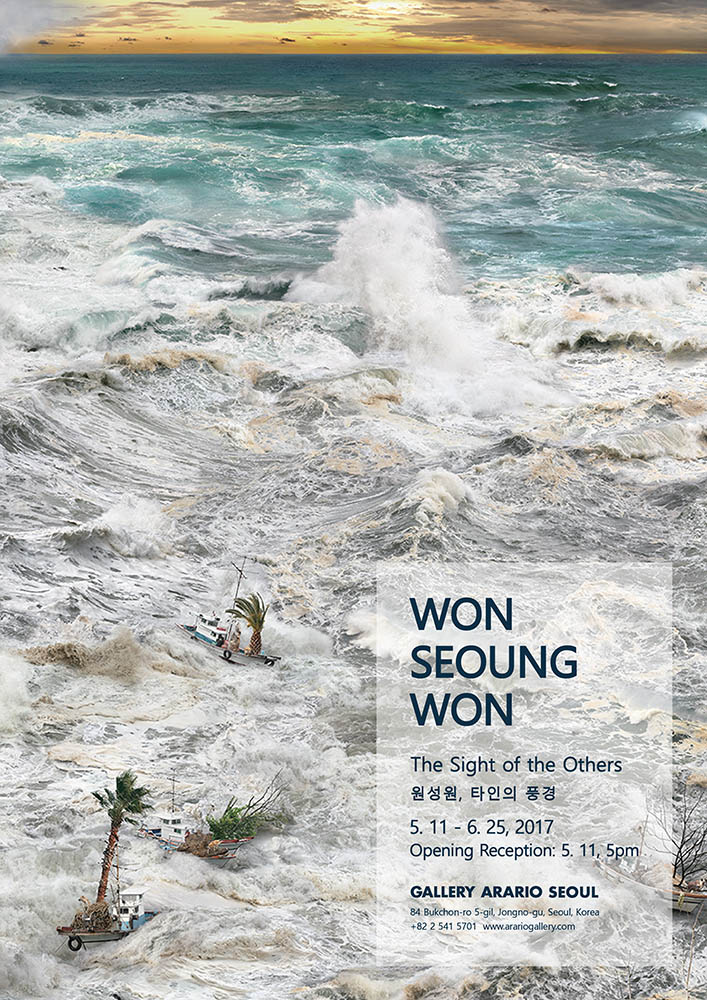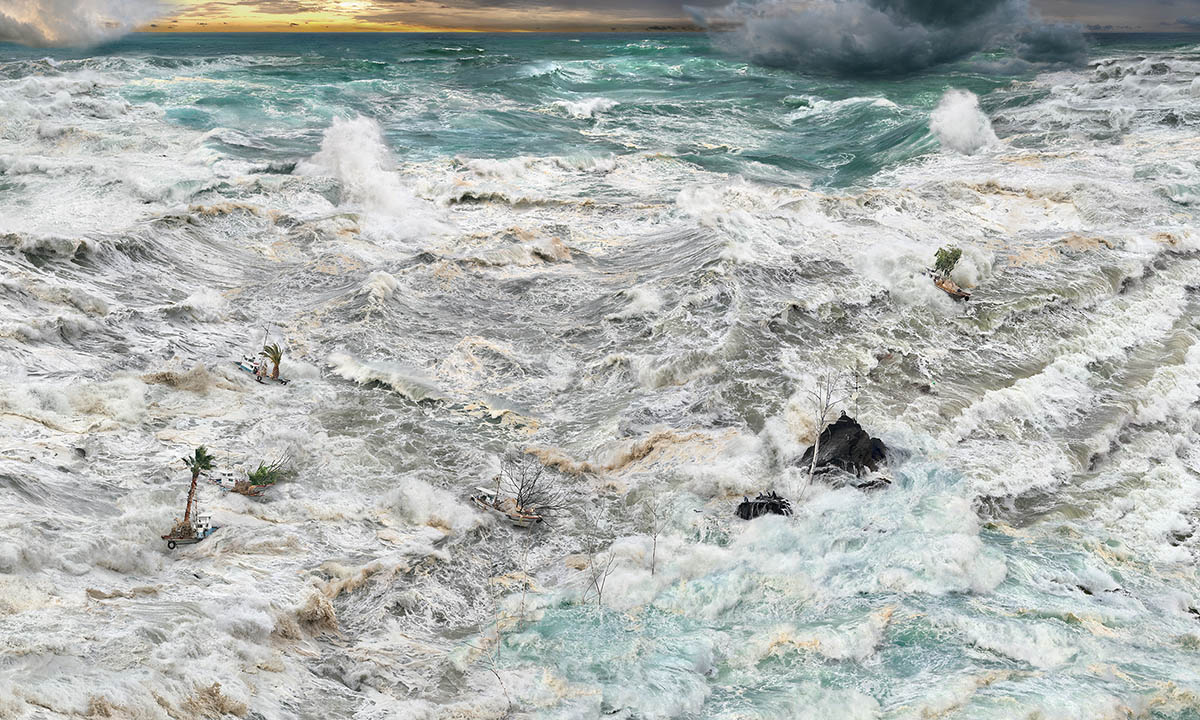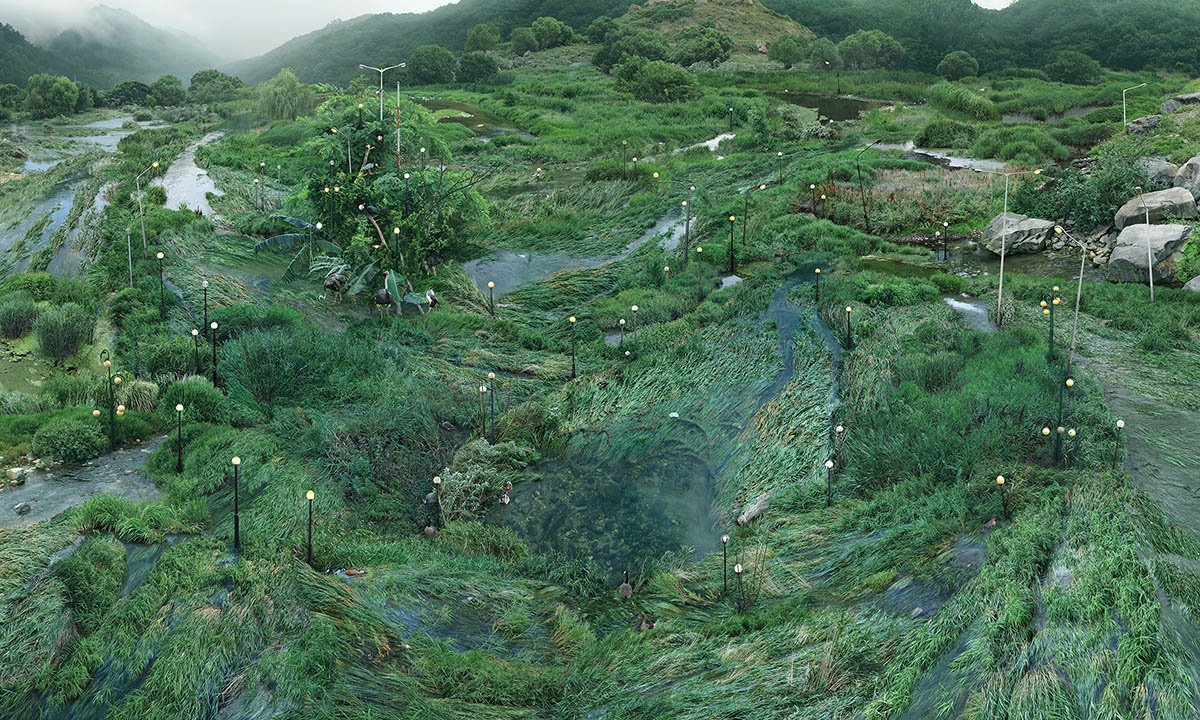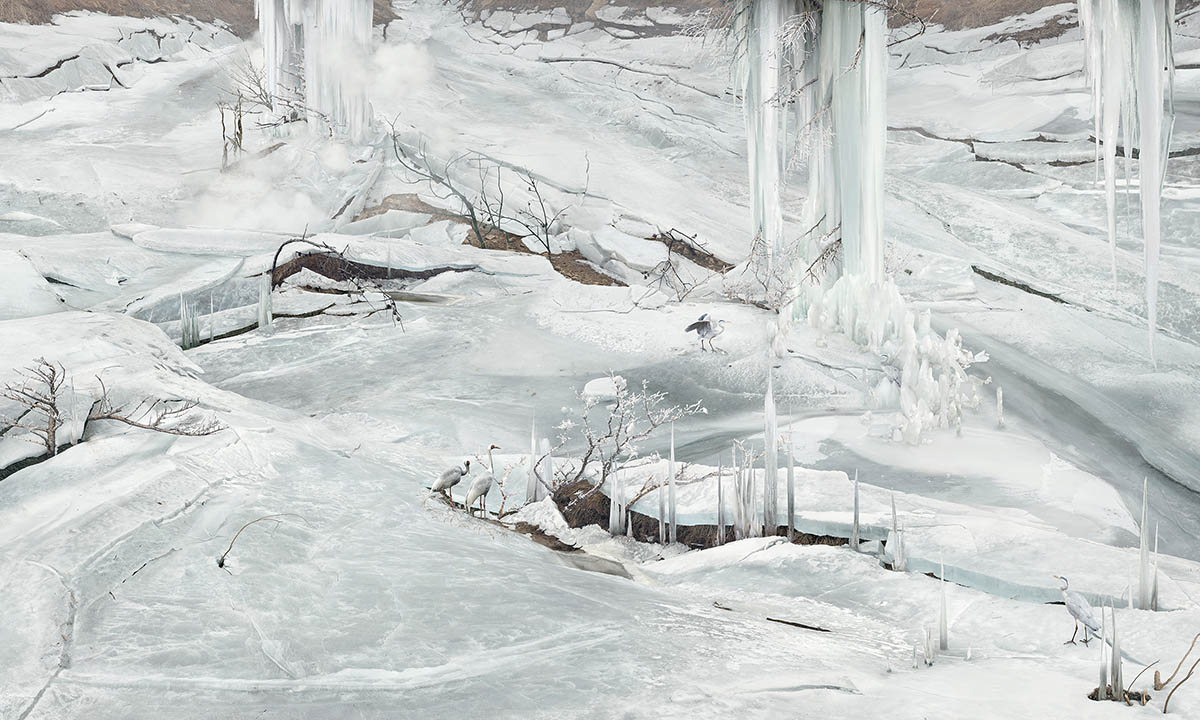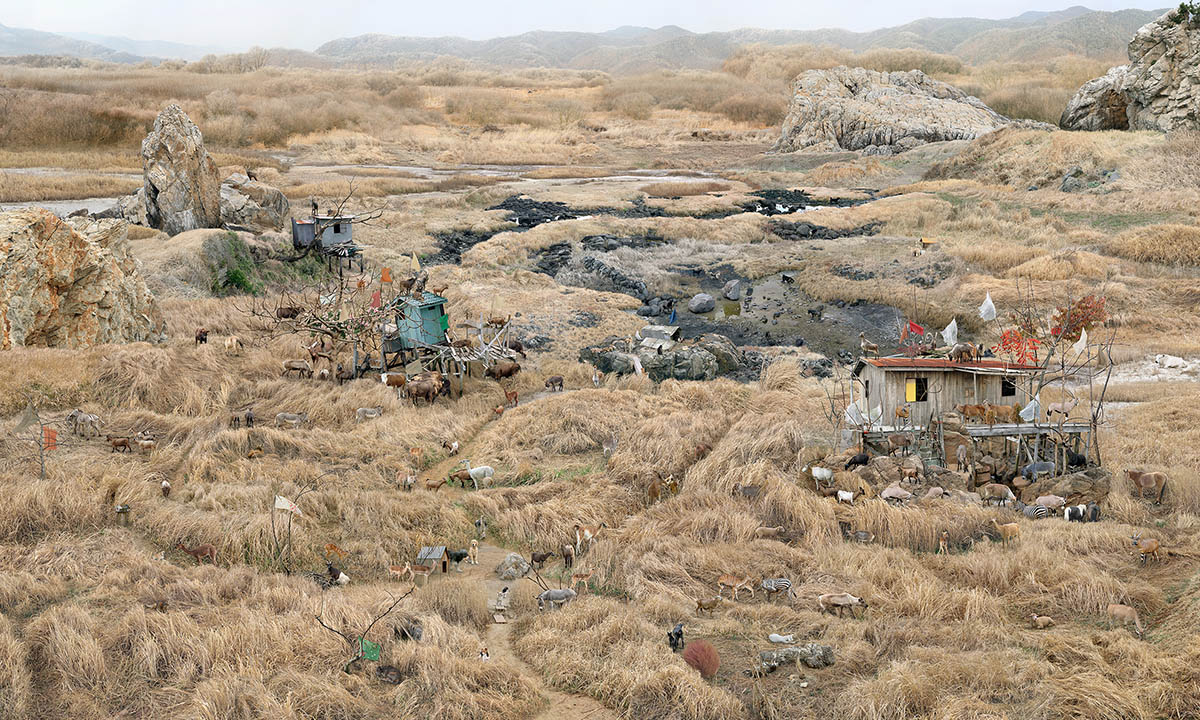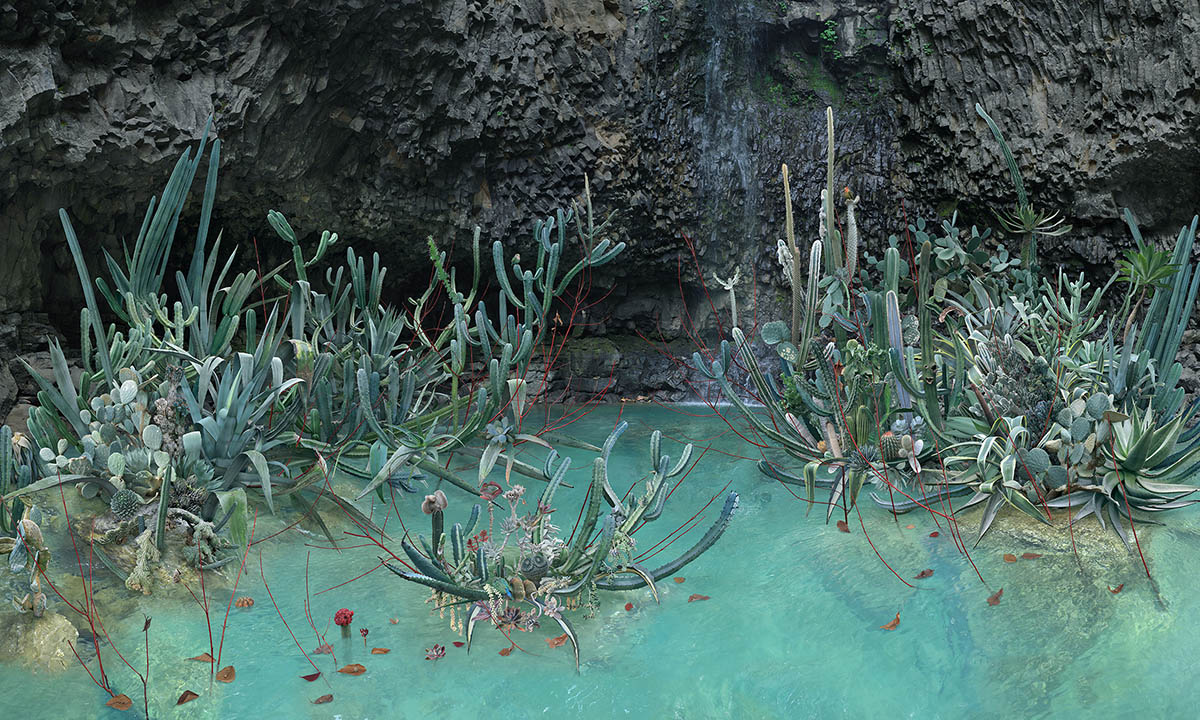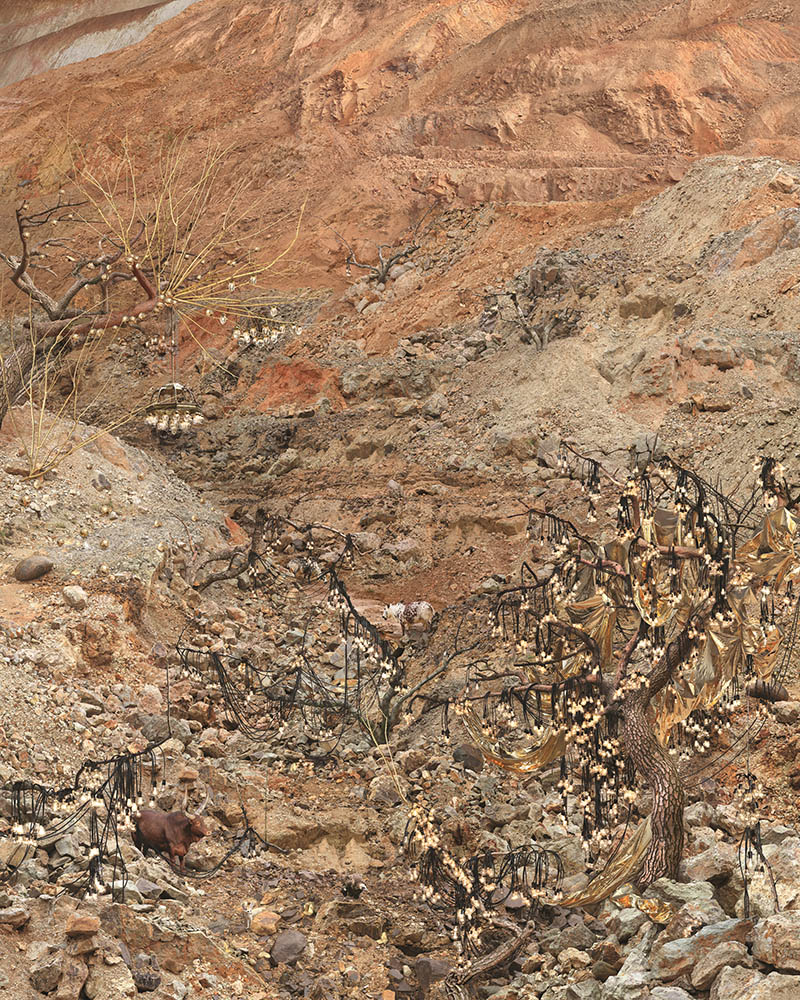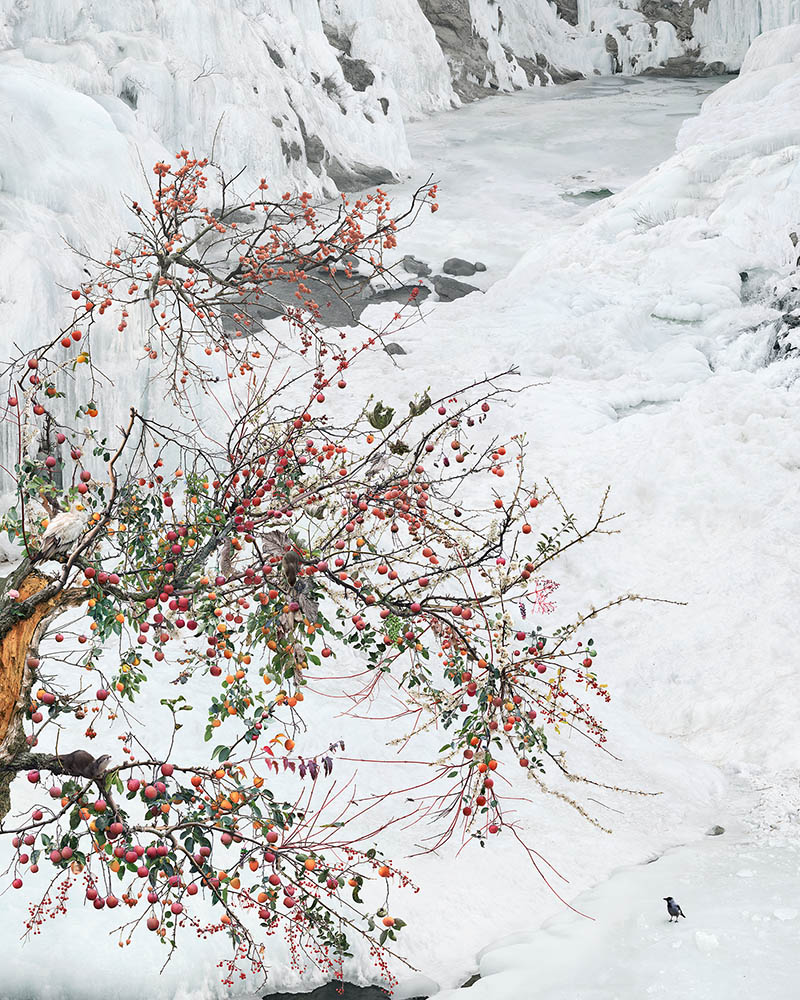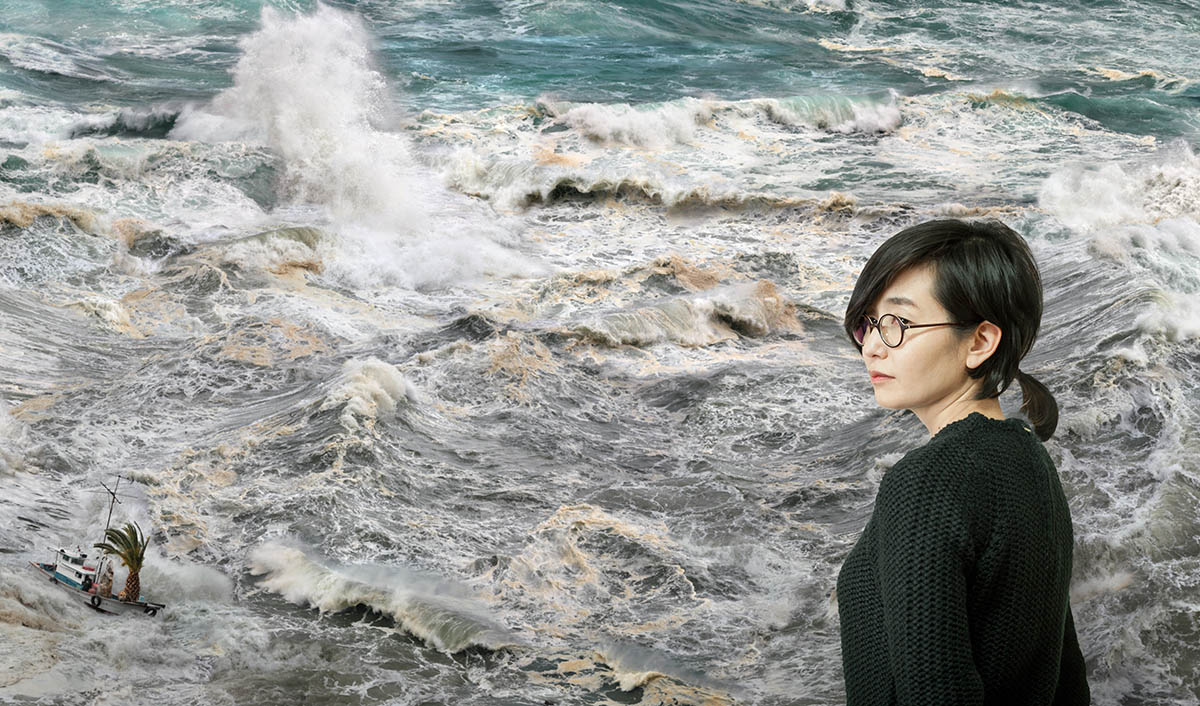Won Seoung Won takes thousands of photographs and creates something real from his unrealistic imagination through an intricate photo-collage process. This is Won’s unique creative procedure where he reorganizes the most appropriate images he collected from the long journeys into a narrative structure. He accentuates the three-dimensional effect by taking numerous photographs of a single part, which physically appears to be one lump. The increase of image layers in comparison to the previous works, presents a frame more convincing than reality. Won Seoung Won collages time and space, unravels the narrative in an intriguing way to induce the eyes of the audience to the picture surpassed of time and space.
The new series of works presented in the solo exhibition,“The Sight of the Others” unveil the occupational platform of journalist • IT specialist • professor • pharmacist • finance specialist • public official • researcher.
Won has been interested in the issue of whether ‘jobs define people’s identities’ as he interacted with people of different professions.And he expresses the seven professions he indirectly experienced through them into different landscapes. The jobs that everyone admires have definite and professional qualities, thus forming its peculiar aura. When we look closer into these superb jobs popular in the society, they all involve similar dilemma and difficulties like any other jobs. Won portrays the gap between the professions that seemed special from a far and the general rigors within those jobs through animals and landscapes. The disparate and unfamiliar sight presented by Won Seoung Won is a reflection of our society. The society of men is unfolded realistically upon the pictorial frame, but it is to find comfort in the fact that this tragic narrative is rather beautiful than being hollow or distressful.
갤러리 아라리오 서울은 전속작가 원성원(b.1972)의 개인전 (타인의 풍경)을 5월 11일부터 6월 25일까지 개최한다. 이번 전시에서 작가는 전문직에 종사하는 지인들의 직업을 동물과 자연 풍경으로 상징화한 7점의 대형 사진들을 보여줄 예정이다.
원성원작가는 3년 동안 수 천 장의 사진을 촬영한 후 정교한 사진 콜라쥬 작업으로 비현실적인 상상을 실제처럼 만든다. 오랜 여행을 통해 찾아낸 가장 적합한 이미지를 서사구조로 재구성하는 작가 특유의 창작과정이다. 심지어 물리적으로 보면 한 덩어리로 찍었을 것 같은 부분도 여러 장으로 찍어 입체감을 살려냈다. 전작에 비해 더욱 많아진 이미지의 레이어는 현실보다 더 실감나는 화면을 연출한다. 작가는 시간과 공간을 콜라쥬하고 내러티브를 흥미롭게 풀어내어 시공간의 틀을 초월한 화면으로 관객의 시선을 유도한다.
개인전 (타인의 풍경 The sight of the others)에서 발표하는 신작은 언론인, IT전문가, 교수, 약사, 금융인, 공직자, 연구원의 직업적 단상을 보여준다.
작가는 여러 직종의 사람들과 교류하며 직업이 사람의 정체성을 결정하는가의 문제에 호기심을 가져왔다. 그리고 그들을 통해 간접 체험한 7개의 직업을 풍경으로 묘사했다. 누구나가 호감을 갖는 직업들은 분명하고 전문적인 특징을 가지며 저마다의 아우라를 형성한다. 사회에서 통용되는 이런 멋진 직업은, 그러나 가까이에서 들여다보면 다른 직업들과 유사한 고민과 어려움을 내포한다. 작가는 멀리서 바라볼 때 특별해 보였던 직업과 그 안에서 나타나는 일반적인 고단함의 간극을 동물과 풍경으로 묘사하였다. 원성원 작가가 보여주는 이질적이면서도 낯선 직업의 풍경은 인간사회의 반영이다. 인간 사회의 풍경이 화면에 사실적으로 펼쳐지지만 그 비극의 서사가 공허하거나 괴롭기는커녕 아름답다는 데서 오는 위안에 공감하고자 한다.
원성원작가는 3년 동안 수 천 장의 사진을 촬영한 후 정교한 사진 콜라쥬 작업으로 비현실적인 상상을 실제처럼 만든다. 오랜 여행을 통해 찾아낸 가장 적합한 이미지를 서사구조로 재구성하는 작가 특유의 창작과정이다. 심지어 물리적으로 보면 한 덩어리로 찍었을 것 같은 부분도 여러 장으로 찍어 입체감을 살려냈다. 전작에 비해 더욱 많아진 이미지의 레이어는 현실보다 더 실감나는 화면을 연출한다. 작가는 시간과 공간을 콜라쥬하고 내러티브를 흥미롭게 풀어내어 시공간의 틀을 초월한 화면으로 관객의 시선을 유도한다.
개인전 (타인의 풍경 The sight of the others)에서 발표하는 신작은 언론인, IT전문가, 교수, 약사, 금융인, 공직자, 연구원의 직업적 단상을 보여준다.
작가는 여러 직종의 사람들과 교류하며 직업이 사람의 정체성을 결정하는가의 문제에 호기심을 가져왔다. 그리고 그들을 통해 간접 체험한 7개의 직업을 풍경으로 묘사했다. 누구나가 호감을 갖는 직업들은 분명하고 전문적인 특징을 가지며 저마다의 아우라를 형성한다. 사회에서 통용되는 이런 멋진 직업은, 그러나 가까이에서 들여다보면 다른 직업들과 유사한 고민과 어려움을 내포한다. 작가는 멀리서 바라볼 때 특별해 보였던 직업과 그 안에서 나타나는 일반적인 고단함의 간극을 동물과 풍경으로 묘사하였다. 원성원 작가가 보여주는 이질적이면서도 낯선 직업의 풍경은 인간사회의 반영이다. 인간 사회의 풍경이 화면에 사실적으로 펼쳐지지만 그 비극의 서사가 공허하거나 괴롭기는커녕 아름답다는 데서 오는 위안에 공감하고자 한다.
타인의 풍경
처음엔 비슷한 길을 걸었을 것이다.
어느 순간 갈라지는 길을 마주하고 고민하다.
각자의 길을 선택하고 전혀 다른 풍경 속으로 걸어 들어갔다.
그렇게 내 길을 걷다가 도착한 곳에서 생각을 해 본다.
이 길 뿐이었을까?
태어나고 죽고의 철학적 고뇌와
먹고 살아내기의 현실의 걱정이 매일 교차되고
나는 왜 태어났는가의 궁금함이
죽을 때까지 잘 살아남을 수 있겠는가의 초조함으로 대체되는 순간도 있다.
그리고 어느 순간부터 보이기 시작한 타인의 삶.
다른 길을 거쳐 도착한 그들의 직업적 풍경
우리는 가까이에서 서로가 도착한 곳을 볼 수 있다.
그곳에서 나에게 말한다. 너의 자유와 비현실적 이상이 좋아 보인다고.
그러면 나도 말한다. 네가 있는 곳이 나와는 비교도 안되게 아름다워 보인다고.
교수. IT전문가. 약사. 금융인. 언론인. 공직자. 연구원
사람들은 직업에 귀천은 없다고 말하면서 그렇지 않다고 생각한다.
가까이 들어가 보면 모든 먹고 사는 수단으로서의 직업은 고단하다.
동시에 멀리서 쳐다보는 직업은 나름대로 이상적이고 꽤 괜찮아 보인다.
넓은 세상 속, 내가 선택한 곳에서 바라본 타인의 풍경
자신들이 맡은 역할과 그 뒤의 특별한 배경이 존재 하는 곳
가능하지 않아서 한번쯤 들어가 보고 싶은 풍경이다.
처음엔 비슷한 길을 걸었을 것이다.
어느 순간 갈라지는 길을 마주하고 고민하다.
각자의 길을 선택하고 전혀 다른 풍경 속으로 걸어 들어갔다.
그렇게 내 길을 걷다가 도착한 곳에서 생각을 해 본다.
이 길 뿐이었을까?
태어나고 죽고의 철학적 고뇌와
먹고 살아내기의 현실의 걱정이 매일 교차되고
나는 왜 태어났는가의 궁금함이
죽을 때까지 잘 살아남을 수 있겠는가의 초조함으로 대체되는 순간도 있다.
그리고 어느 순간부터 보이기 시작한 타인의 삶.
다른 길을 거쳐 도착한 그들의 직업적 풍경
우리는 가까이에서 서로가 도착한 곳을 볼 수 있다.
그곳에서 나에게 말한다. 너의 자유와 비현실적 이상이 좋아 보인다고.
그러면 나도 말한다. 네가 있는 곳이 나와는 비교도 안되게 아름다워 보인다고.
교수. IT전문가. 약사. 금융인. 언론인. 공직자. 연구원
사람들은 직업에 귀천은 없다고 말하면서 그렇지 않다고 생각한다.
가까이 들어가 보면 모든 먹고 사는 수단으로서의 직업은 고단하다.
동시에 멀리서 쳐다보는 직업은 나름대로 이상적이고 꽤 괜찮아 보인다.
넓은 세상 속, 내가 선택한 곳에서 바라본 타인의 풍경
자신들이 맡은 역할과 그 뒤의 특별한 배경이 존재 하는 곳
가능하지 않아서 한번쯤 들어가 보고 싶은 풍경이다.
The Sight of Others
Perhaps we might have walked similar paths.
At some point, we stand in distress before the parted roads.
We choose different paths on our own and walked into completely different landscapes.
As I walked my path, I fall into contemplation at an arrival.
Was this the only way?
With the philosophical agony of birth and death,
And having mixed concerns of making ends meet everyday,
The curiosity of ‘Why am I born’ is
sometimes replaced with the anxiety on how could I survive until the end.
Then the lives of others come into sight at a certain point.
Their arrival of professional settings as they took a different path
We could see each other’s point of arrival in close contact.
They tell me from there. Your freedom and unrealisticideals seems good.
Then I tell them too. Your place seems far more beautiful than where I am.
Professors.ITSpecialists.Pharmacists.Financiers.Journalists.Government Officers.Researchers.
People say all occupations are equally honorable, but they also think this is not quite true.
In a close up, every occupation as a device for making ends meet is distressful.
At the same time, every occupation seems rather idealistic and fine from a distance.
The sight of others seen from the place I chose within this vast world,
The place where each person’s role and special settings exist according to the roles,
This is the landscape I wish to enter once, as it is impossible.
Won Seoung Won
Perhaps we might have walked similar paths.
At some point, we stand in distress before the parted roads.
We choose different paths on our own and walked into completely different landscapes.
As I walked my path, I fall into contemplation at an arrival.
Was this the only way?
With the philosophical agony of birth and death,
And having mixed concerns of making ends meet everyday,
The curiosity of ‘Why am I born’ is
sometimes replaced with the anxiety on how could I survive until the end.
Then the lives of others come into sight at a certain point.
Their arrival of professional settings as they took a different path
We could see each other’s point of arrival in close contact.
They tell me from there. Your freedom and unrealisticideals seems good.
Then I tell them too. Your place seems far more beautiful than where I am.
Professors.ITSpecialists.Pharmacists.Financiers.Journalists.Government Officers.Researchers.
People say all occupations are equally honorable, but they also think this is not quite true.
In a close up, every occupation as a device for making ends meet is distressful.
At the same time, every occupation seems rather idealistic and fine from a distance.
The sight of others seen from the place I chose within this vast world,
The place where each person’s role and special settings exist according to the roles,
This is the landscape I wish to enter once, as it is impossible.
Won Seoung Won
언론인의 바다The Sea of Journalists, 2017, c-print
언론인들의 공정한 보도는 이상적인 직업 윤리이며 그런 언론인의 시각적 포지션에 대한 풍경이다. 사건, 또는 상황을 진실하게 또는 공정하게 바라보는 입장에서 언론인의 위치는 매우 중요하다. 서있는곳이 어디냐에 따라 보이는것 이 달라지기 때문이다.
파도치는 바다에서 출렁이는 배를 타고 보는 파도의 방향과 사이즈는 고정된 섬에서 고정된 시선으로 보는 파도와 큰 차이를 보인다. 언론의 견해가 그들이 자리잡은 상황에 따라 달라지는 모습을 볼수 있으며 격동치는 파도 한 가운데 서서 보도하는 생생한 즐거움과 함께 서로 다른 견해차이를 극복할수 있는가에 대한 고뇌도 느껴진다.
IT전문가의 물풀 네트워크The Water-grass Network of IT Specialists, 2017, c-print
구글이나 네이버등 포털에서 가상공간을 만들어 네트워크를 형성하는 IT업계 전문직에 대한 풍경이다. 문화의 흐름, 유행의 선도까지 많은 부분을 우리는 네트에 접속하여 바라본다. 네트 접속을 도와주는 등불이 있고 물에 뿌리를 박고 자라는 풀들은 물의 흐름과 세기에 따라 쓰러짐의 모양이 다양하게 나타난다.
모든 풀들은 물이라는 형상이 정해져 있지 않은 거대한 흐름에 따라 모습을 달리한다.
가상의 공간(형태없는물)때문에 현실의 이슈(풀의 모양)가 생겨나는 다른 차원의 전문직의 풍경이다.
공직자의 얼음기둥 The Ice Pillars of Government Officials, 2017, c-print
공직자는 나라의 살림을 실행하는 사람으로서 도덕성과 정직함 투명성등이 요구된다. 얼음강으로 상징화된 공정성 사이로 얼음들이 깨진다. 인간의 출세의 욕구가 깨어진 얼음 위로 뻗어 오르고 때마침 위에서 내려오는 고드름과 만나 기둥이 만들어 지면서 권력이 생겨나는 직업 특성상의 지향점(권력)을 강조한 작업이다.
위엄 있고 명예로운 학이 얼음 사이에서 생겨나는 아름다운 권력을 바라보는 모습도 보인다. 권력 가장 가까이에서 일하는 그들을 상상하며 어쩌면 권력은 가장 아름답기 때문에 많은 이들이 가지려 하는것 이 아닌가 생각한다.
교수의 바람들판The Windy Fields of Professors, 2017, c-print
드넓은 들판에 나약하고 건조한 갈대들이 꽉 차있다.
초식동물들이 그 갈대밭 사이를 오가며 갈대의 땅을 갈라놓고 방향을 잡아주며 다양성을 제시한다.
들판이 조망되는 상대적으로 높은 집(대학)위에서 연륜높은 학자들이 더 먼곳의 풍경을 바라보며 아래에 있는 동물들에게 나아갈 길을 알려준다.
연구원의 선인장The Cactuses of Researchers, 2017, c-print
일정한 공간안에서 같은 목표점에 도달하기 위해 경쟁하는 연구원의 모습을 상징화 했다.
깊은 동굴안에서 물이 점점 차오르고 연구원(새)은 세 그룹의 선인장을 물에 잠기기전에 위로 빠르게 자라게 하거나 물에서도 살아남는 기술을 개발하여 살려야 한다.연구원의 고립되어 있지만 목표 집중적인 상황을 연출한 이미지다.
금융인의 돌산The Quarries of Financiers, 2017, c-print
주식과 펀드등 실물이 아닌 보이지 않는 돈의 상대적 가치를 가지고 수익을 내는 직업에 대한 이미지다. 일반인들에겐 평범하고 쓸모 없는 돌들, 흙들이 금융인의 눈으로 보면 황금화가 가능한 재화로 보이는 채석장같은 풍경이다. 겉으로는 평범해 보이는 돌은 네트로 연결되어 보여지는 주식시장의 수치와 그래프(전선에 연결된 전구 들의 높낮이나 쏠림등)를 통해 가치높은 황금이 되기도 하고 다시 돌이 되기도 하는 연금술 같은 직업 풍경이다.
약사의 실험나무The Experimental Trees ofPharmacists, 2017, c-print
증상에 따라 약을 조합하여 병을 낫게 해주는 약사의 풍경이다. 약은 화학적 구조를 가진다. 가장 기본에 되는 물질을 여러 배합에 맞춰 재조합 한다. 약의 화학적 구조를 연상시키는 나무와 다양한 열매가 나뭇가지로 연결되어 있고 이들이 조화를 이루어 결국 한방울의 약이 제조되는 실험의 상황을 이미지화한 것이다.
언론인들의 공정한 보도는 이상적인 직업 윤리이며 그런 언론인의 시각적 포지션에 대한 풍경이다. 사건, 또는 상황을 진실하게 또는 공정하게 바라보는 입장에서 언론인의 위치는 매우 중요하다. 서있는곳이 어디냐에 따라 보이는것 이 달라지기 때문이다.
파도치는 바다에서 출렁이는 배를 타고 보는 파도의 방향과 사이즈는 고정된 섬에서 고정된 시선으로 보는 파도와 큰 차이를 보인다. 언론의 견해가 그들이 자리잡은 상황에 따라 달라지는 모습을 볼수 있으며 격동치는 파도 한 가운데 서서 보도하는 생생한 즐거움과 함께 서로 다른 견해차이를 극복할수 있는가에 대한 고뇌도 느껴진다.
IT전문가의 물풀 네트워크The Water-grass Network of IT Specialists, 2017, c-print
구글이나 네이버등 포털에서 가상공간을 만들어 네트워크를 형성하는 IT업계 전문직에 대한 풍경이다. 문화의 흐름, 유행의 선도까지 많은 부분을 우리는 네트에 접속하여 바라본다. 네트 접속을 도와주는 등불이 있고 물에 뿌리를 박고 자라는 풀들은 물의 흐름과 세기에 따라 쓰러짐의 모양이 다양하게 나타난다.
모든 풀들은 물이라는 형상이 정해져 있지 않은 거대한 흐름에 따라 모습을 달리한다.
가상의 공간(형태없는물)때문에 현실의 이슈(풀의 모양)가 생겨나는 다른 차원의 전문직의 풍경이다.
공직자의 얼음기둥 The Ice Pillars of Government Officials, 2017, c-print
공직자는 나라의 살림을 실행하는 사람으로서 도덕성과 정직함 투명성등이 요구된다. 얼음강으로 상징화된 공정성 사이로 얼음들이 깨진다. 인간의 출세의 욕구가 깨어진 얼음 위로 뻗어 오르고 때마침 위에서 내려오는 고드름과 만나 기둥이 만들어 지면서 권력이 생겨나는 직업 특성상의 지향점(권력)을 강조한 작업이다.
위엄 있고 명예로운 학이 얼음 사이에서 생겨나는 아름다운 권력을 바라보는 모습도 보인다. 권력 가장 가까이에서 일하는 그들을 상상하며 어쩌면 권력은 가장 아름답기 때문에 많은 이들이 가지려 하는것 이 아닌가 생각한다.
교수의 바람들판The Windy Fields of Professors, 2017, c-print
드넓은 들판에 나약하고 건조한 갈대들이 꽉 차있다.
초식동물들이 그 갈대밭 사이를 오가며 갈대의 땅을 갈라놓고 방향을 잡아주며 다양성을 제시한다.
들판이 조망되는 상대적으로 높은 집(대학)위에서 연륜높은 학자들이 더 먼곳의 풍경을 바라보며 아래에 있는 동물들에게 나아갈 길을 알려준다.
연구원의 선인장The Cactuses of Researchers, 2017, c-print
일정한 공간안에서 같은 목표점에 도달하기 위해 경쟁하는 연구원의 모습을 상징화 했다.
깊은 동굴안에서 물이 점점 차오르고 연구원(새)은 세 그룹의 선인장을 물에 잠기기전에 위로 빠르게 자라게 하거나 물에서도 살아남는 기술을 개발하여 살려야 한다.연구원의 고립되어 있지만 목표 집중적인 상황을 연출한 이미지다.
금융인의 돌산The Quarries of Financiers, 2017, c-print
주식과 펀드등 실물이 아닌 보이지 않는 돈의 상대적 가치를 가지고 수익을 내는 직업에 대한 이미지다. 일반인들에겐 평범하고 쓸모 없는 돌들, 흙들이 금융인의 눈으로 보면 황금화가 가능한 재화로 보이는 채석장같은 풍경이다. 겉으로는 평범해 보이는 돌은 네트로 연결되어 보여지는 주식시장의 수치와 그래프(전선에 연결된 전구 들의 높낮이나 쏠림등)를 통해 가치높은 황금이 되기도 하고 다시 돌이 되기도 하는 연금술 같은 직업 풍경이다.
약사의 실험나무The Experimental Trees ofPharmacists, 2017, c-print
증상에 따라 약을 조합하여 병을 낫게 해주는 약사의 풍경이다. 약은 화학적 구조를 가진다. 가장 기본에 되는 물질을 여러 배합에 맞춰 재조합 한다. 약의 화학적 구조를 연상시키는 나무와 다양한 열매가 나뭇가지로 연결되어 있고 이들이 조화를 이루어 결국 한방울의 약이 제조되는 실험의 상황을 이미지화한 것이다.
풍경, 그 욕망의 세부
글 : 최연하 (사진평론가)
원성원의 작품이 그간 보여준 다양한 서사와 이미지의 활력은 그 자체의 상징과 재미를 음미하고 분석하는 것만으로도 많은 관객과 평자를 분주하게 만들었다. 특히 수고로움으로 집적된 두터운 이미지의 상징코드를 해독하는 재미는 작가와 관객 사이에 구연적 소통을 마련한 특별한 예가 되었다. 《My Life》(1999)로 시작해 《Dream room》(2000~2004), 《Tomorrow》(2008), 《My Age of Seven in 1978》(2010), 《Character Episode》(2013) 등 원성원은 나와 가족, 친구들과 이웃의 이야기를 특이한 이미지언어로 대응해냄으로써 사진과 회화, 문학과 영화를 응집시킨 새로움을 제시했다. 그러니 원성원의 작품을 읽을 때 이미지의 돌발적 제시나 서사양식의 이종교배에서 나오는 비의들을 탐색하는 재미는 그의 사진을 보는 관객에게 거의 빠지지 않고 나오는 반응일 수밖에 없었을 것이다. 그의 서사는 쉽고 명확하고 절제된 가운데 언제나 조심스러운 우회로를 택하고 있다. 이야기가 끝나는 지점에서 거듭되는 새로운 시작과 계속 이어지는 흐름을 통해 새로운 발단을 야기하거나, 동일한 대상인 것 같지만 상이한 의미를 발견하게 한다. 디지털 후가공을 통해 변화무쌍한 이미지 조각들을 이어붙이며 촘촘히 엮여낸 그의 사진은 매우 주의 깊게 지어진 건축물을 보는 듯했다.
4년 만에 만나게 된 신작, <타인의 풍경>에서 원성원은 일곱 개의 원시적인 풍경을 펼쳐낸다. 마치 미술사 초기의 풍경화가 흔히 제시하듯 풍경과 서사의 코드를 풀어내는 데 몰두하게 하지만, 인간의 이해의 영역에 결코 포섭될 수 없는 자연의 섭리처럼, <타인의 풍경>은 거칠고 불규칙적이고 무질서하게 드러나며 원성원이 전작에서 보여준 친절한 상징코드들을 와해시킨다. 관객의 혼선을 덜하기 위해 작가는 일곱 개의 풍경에 주제어를 심어놓았다. ‘교수, IT전문가, 약사, 금융인, 언론인, 공직자, 연구원’이 모티브가 된 이 풍경들 속에 사람은 어디에도 보이지 않는다. 사람이 있어야 할 자리에 대신 동물들이 있다. 동물들은 사나운 파도가 일렁이는 광막한 바다와 험한 산악지대, 얼음 계곡과 신비로운 늪, 풀들이 무성한 대지의 전경과 후경에 점점이 박혀있다. 마치 거대한 자연에 작고 유한한 인간을 대비 시키듯 ‘사람 같은 동물’이 현대사회의 주요 직업을 대표하는 인물이 되었다. 그것도 인적이 드물고 아직 사람의 발길이 닿지 않은 곳에 말이다. 그 탄생과 유행이 자본주의와 인간주의의 역사와 맞물린 풍경화의 속성을 생각하면 원성원의 ‘새로운 풍경’은 다소 읽기의 난해를 동반하며 아름답고 즐거운 공포 속으로 관객을 초대하고 있다. 우리의 시선이 불편하지 않도록 적절히 조망할 수 있는 위치에서 풍경을 체험하게 하면서, 그리고 인간의 시각으로는 포착할 수 없는 드넓은 풍광을 ‘한 눈에’ 보여주면서, 원근을 해체하며 가장 ‘자연스러운’ 방식으로, 중심과 주변을 구분하지 않고 보이는 대로 보게 하는 것. 이처럼 원성원의 <타인의 풍경>은 늘 꿈꾸던, 그래서 ‘그림 같은’ 풍경이 무한하게 펼쳐진다. 타인의 풍경 속에서 신나게 어울려 놀다보니 어느 새 타인이 내 안에서 ‘나’를 꿈꾸게 되고, 나를 꿈꾸는 네가 ‘나’였을지도 모른다는 생각에 이르면 풍경의 세부도 이렇게 명징하고 선명해 질 수 있을까.
타인을 감싸는 풍경의 리듬
인간에 의해 재편된 자연을 ‘풍경’이라고 한다면, 풍경은 자연에 덧씌워진 인간의 시선일터, 타인도 어쩌면 ‘나’의 시각에 의해 편집된 환영일지도 모른다. 원성원은 <타인의 풍경>에서 모티브가 된 실제 인물들을 만나며 그들의 직업 세계를 추체험해본다. 이미, 오래 전부터 ‘예술가’인 그에게, ‘교수, IT전문가, 약사, 금융인, 언론인, 공직자, 연구원… ’의 세계는 약간의 부러움과 동경의 ‘아르카디아’였을 것이다. 픽처레스크(picturesque)처럼 그림 그리기에 ‘적절’하고 비교적 쾌적한 삶의 풍경을 현대인이라면 한번쯤 욕망하듯, 원성원도 타인의 풍경을 처음에는 ‘조망’했다. 그러다 풍경 속으로 들어간 원성원이 발견하게 된 것은 빛과 바람의 방향에 따라 미묘하게 움직이는 나뭇가지와 풀과 구름과 그림자와 먼지의 일렁임이었다. 해독할 수 없는 수수께끼와, 각자의 독자적인 언어도 보였다. 혹은 ‘자연스럽게’ 보이도록 각색되거나 왜곡된 풍경도 목도했을 것이다. ‘타인의 삶의 풍경’도 나의 풍경과 별반 다름없이 불규칙하고 거칠고 고루하고 결핍된 형식으로, 각자가 잃어버린 이미지들을 타인 속에서 찾고 확인하기 위해 떠나는 ‘픽처레스크 여행’ 같았다. 원성원의 작품 속에서 어디에나 있을 법한 풍경은, 사실 어디에도 없는 풍경이다. 내가 늘 꿈꾸었던 ‘네’가 이미 내 안에 부재로 존재해 왔듯이, 타인은 내가 욕망한 ‘나’이기에 영원히 재현 불가능하고 안팎을 넘나들며 끊임없이 허물어지는 ‘바람이고 그림자(풍경風景)’인 것이다.
풍경사진의 아름다움을 기대한다면, 원성원의 <타인의 풍경>은 낯설고 기이하겠지만, 나와 타인의 관계성을 사유한다면 ‘부드러운 떨림’을 안겨줄 것이다. 원성원은 그 자체로 독립적이고 개별적인 낱낱의 풍경들을 채집하고 더 나아가 각각의 이미지들을 다른 이미지와의 ‘관계’를 통해 매우 다층적으로 드러낸다. 그의 사진에서 ‘한 덩이’처럼 보이는 풀들과 파도와 얼음계곡과 호수는 사실 500개, 1000개의 이미지로 이뤄진 것이다. 존재 이해의 저편에 있는 타자와의 만남이 나와 하나로 동일시 될 때가 아닌 각각의 특이성이 살아 있을 때 비로소 긴밀하게 밀착될 수 있듯이, 한 존재가 다른 존재와의 관계를 통해 역동적인 변화가 생성되는 지점도 이처럼 투명하게 번역되지 않는 타인을 감싸는 풍경의 리듬에 의해 가능할 것이다. 원성원이 한 장의 사진을 만들어내기 위해 1000여 개의 이미지를 중첩시키고, 2~3개월이라는 제작 기간이 필요한 것도 시•공이 다른 풍경에 잠재한 이미지를 생생하게 다시 살려내고자 함이다. 타자화 된 자연이 아니라 우리 앞에 실제 하는 자연은 그 자체로 힘의 응집체이자 끊임없이 움직이며 변화하기에.
알레고리, 경험, 사진적 사실
원성원은 변화하는 자연 속에서, 그 ‘자연스러움’을 드러내고자 주의 깊고 치밀한 관찰을 시도한다. 자연의 광대함에 개인의 실존적인 의미를 투사하는 대신, 변화하고 소용돌이치고 때론 폭력적이기도 한 과정으로서의 자연을 표상하고 싶었던 것이다. 예의 낭만주의자의 숭고한 풍경처럼 거대한 스케일의 사진이 나오기까지, 네 개의 태풍을 따라다니며 2년에 걸쳐 촬영하거나(언론인의 바다), ‘공직자의 얼음기둥’은 얼었던 강이 슬슬 녹을 때까지 기다렸다가 경북 청송의 한 강가에서 촬영한 것이다. 역시 두 해에 걸쳐 촬영해야 했다. 큰 비가 내린 직후에 여러 지방의 하천을 다니며 수집한 풀 이미지는 ‘IT전문가의 물풀 네트워크’를 형성하였다. 원성원의 사진 꼴라주는 포토샵 프로그램에서 사진을 합성하는 과정을 거치며 탄생했다. 지극히 오랜 시간을 요하는 노동집약적이고 아날로그적인 작업이다. 이 때 작가만의 원칙이 있는데, 한 번 이야기에 등장한 이미지는 이후로 어디에도 나타나지(사용하지) 않는다는 것이다. 언젠가 나는 원성원에 대한 작가론을 쓰면서, ‘실로 방대한 사진기호들이 모이고 엮여 직조된 이야기가 원성원의 사진이다. 다양한 사연이 담긴 개별자의 삶의 무늬, 그 무늬를 빚어내는 바람과 햇살과 밤과 낮의 시간은 매순간, 모두 다르다. 삶의 무늬들이 비슷하더라도 그 속살은 각자에게만 속한 특이한 영역이기에 실재하는 이야기를 풀어내는 작가는 고유한 경험들을 가진 한 컷 한 컷의 사진을 찍는 것이 중요했던 것이고, 이것은 원성원 작품의 견고한 형식이 된다. 분명히 실재했던 것을 찍어내는 사진 예술에만 고유하게 내재한 특성을 가로질러 환상을 불러들인 것’이라고 강조한 바 있는데, 실재의 흔적으로서의 사진의 인덱스(photo-index)적인 측면은 그의 사진에서 중요한 미덕이라고 할 수 있다. 사진적 사실주의와 작가의 상상력이 결합하고, 여기에 이야기와 경험이 중첩되면서 하나의 ‘성좌구조(Konstallation)’를 형성하는 것이다.
작업을 진행하는 동안 원성원은 ‘교수, IT전문가, 약사, 금융인, 언론인, 공직자, 연구원’을 닮고, 그들의 세계를 경험하며 일종의 미메시스의 과정에 이르렀을 것이다. 원성원의 미메시스적 유희의 실현과정은 마치 어린 아이들의 놀이처럼 난데없고 구성 불가능한 것들로 이뤄졌다. 보이지 않는 네트워크망은 큰 비에 휩쓸려 방향이 제멋대로인 ‘물풀’로, ‘약사’로 등장하는 주둥이가 노란 새는, 아픈 검은 새에게 약을 주기 위해 각종의 꽃과 다양한 열매가 맺힌 나무의 가지들을 거쳐 단 한 방울의 약을 조제해준다. 그 뒤의 얼음 계곡은 모든 것이 멸균된 상태라고. ‘교수의 바람들판’은 또 어떠한가. 학생들은 ‘건초’이고, 건초 더미 위에 지어진 곧 쓰러질 것처럼 위태로운 학교에서 건초들을 바라보는 초식동물이 교수가 된다. 연구원은 앵무새로, 얼룩소와 독수리와 여우는 금융인이 되었다…. 그의 사진에 등장하는 펭귄, 들소, 까마귀, 개, 고양이, 초식동물 등은 기존의 상징체계와 무관하게 자의적이고 이질적으로, 개별적인 것들이 독자적인 지위를 갖고 있으면서 상호관계 속에서 새로운 구조를 형성하고 있다. 벤야민이 언급한 ‘알레고리’의 구성원리이기도 하다. 이미지와 의미가 고정된 것이 아니라, 파편적이고 단편적인 무수한 이미지들이 모이고 흩어지면서 새로운 형태를 띠기도 하고, 의미가 형성되는 것이다. 그리고 이미지와 의미 사이에서 결코 번역될 수 없는 행간도 보인다. 이처럼 원성원의 미메시스적 경험은 정보를 전달하기엔 희박하지만 ‘어떤 경험’으로 풍요롭다. 주의력과 상상력을 갖고 동물들이 어떻게 거동하고 숙고하는지를 탐구하는 그에게 현실은 사진으로 재현될 수 없는 단지 여러 느낌들로 이뤄진 독특한 리얼리즘의 세계이다.
벤야민의 「베를린의 유년시절」에 실린 단편, <무메렐렌 Die Mummerehlen>에는 한 아이가 등장한다. 아이는 구름과 가구와 옷들과 스스로 유사해지려고 한다. 그런데 다른 사람들이 아이에게 그 자신과 닮을 것을 요구하면 당혹스러워 하는데, 바로 사진을 찍을 때가 그랬다고 한다. ‘타인의 풍경’ 속으로 들어가는 일은 어쩌면 자신을 지우는 일일지도 모른다. 그것은 사진을 찍을 때처럼 세계-타인을 동일하게 옮겨오는 차원이 아니다. 타인을 만나고, 경험하는 것은 광활한 자연 속에서 동물의 몸짓을 따라하는 것처럼 고독한 일이다. 원성원이 <타인의 풍경>에서 ‘펭귄’이 되어 바다에 뛰어든 이유가 아닐까.
Sight,the Details of its Desire
CHOI Yeonha(Photography Critic)
The vitality of colorful narrative and image found in the works of Won Seoung Won kept its many audiences and critics busy just by appreciating and analyzing the symbols and amusement within. Especially the fun of deciphering the thick code of symbolism, accumulated with painstaking, labor has become a special example that enabled narrative communication between the artist and the audience. From My Life (1999) to Dream room (2000~2004), Tomorrow (2008), My Age of Seven in 1978 (2010), to Character Episode(2013) and etc., Won took the stories of herself, family, friends and neighbors and corresponded them into peculiar image language, thus suggesting something new combined with photography, painting, literature and film. Therefore, the audience always responds to her photography by exploring the intriguing comparisons from the crossbreeding of narrative form or provocative suggestion found in her works. Her narrative takes a careful detour while being easy, clear and moderate. It creates new exposition through the repetition of new beginnings at the end of the story or leads to discover different meaning from the identical subject. Her photography mirrors a carefully built architecture, as it is densely interweaved with kaleidoscopic image segments through digital post-processing.
Won exhibitsher new series in four years, The Sight of the Others with seven primitive landscapes. As the landscape paintings of the early art history suggests, it leads to solving the code of its narrative and landscape, but like the provision of nature which can never be understood by men, The Sight of the Others is rough, irregular and disorderly which reveals while breaking down every considerate symbolic codes in her previous works. Won had planted different keywords in the seven landscapes to minimize the confusion of the audience. Men are not present in these landscapes where ‘professors, IT specialists, pharmacists, finance specialists, journalists, government officials, researchers’ were taken as motifs. Animals have replaced human beings. Animals are situated here and there amidst the fierce waves of the vast ocean and rugged mountains, icy streams and mysterious swamps, and foreground and background of the fields full of overgrown trees. As if contrasting the small, ephemeral mankind in the face of colossal nature, the ‘manlike animals’ have explored the representative figures of the modern society.Furthermore, they are situated at desolate places out of human reach. Thinking about theattributes of the landscape painting occluded with the birth and trend of the history of capitalism and humanism, the ‘new landscape’ of Won Seoung Won invites the audience into a beautiful and cheerful fear accompanied with difficult reading. Guiding us to experience the landscape at an appropriate position where our perspectives are comfortable, and displaying the open scenery ‘at a glance’, impossible to be captured by human eyes; dismantling the perspective in the most ‘natural’ way, enabling us to see it as it is without dividing the center and surroundings.As such, Won’s The Sight Of the Others unfolds the infinite ‘picture-like’ landscape of the dreams. Cheerfully hanging around in the sight of others, others come to dream of‘myself’ in me, and when I reach the point where you might have been ‘myself’ who dreamt of me, and thenwould the details of the landscape become so lucid and distinct.
Rhythm of LandscapesEmbracing Others
If ‘landscape’ was nature reorganized by men, then landscape would be nature overlaid with the sight of men, and others may also be illusions edited by ‘my’ sight.Won has met with the real professionals who motivated The Sight of the Others and experienced their professional world. To Won Seoung Won, who has been an ‘artist’ for a long time, the world of ‘professors, ITspecialists, pharmacists, finance specialists, journalists, public officials, researchers…’ would’ve been an ‘Arkadia’ mixed with a bit of envy and yearning. As any contemporary men would desire for a relatively pleasant life, ‘well-fitting’ to be painted like picturesque, Won also took a ‘view’ of the sight of others at first. Then when she enters the landscape, she finds the subtle movement of branches, grass, clouds, shadows and dusts swaying in accordance with the direction of light and wind. She also saw indecipherable riddle and each independent language or may have witnessed dramatized or distorted scenes to appear ‘natural’. It was like a ‘picturesque journey’ to search the lost images from others in confirming that the ‘sight of the others’ lives’ were just as irregular, rough, mundane and deficient like my own. The landscape in Won Seoung Won’s works, which seems to exist anywhere, actually does not exist anywhere. As ‘you’ who I dreamt of existed as absence within myself, others are ‘myself’ in my desires that it is eternally impossible to reenact and also the ‘wind and shadow’ that endlessly collapse inside and out.
If you were anticipating beautiful landscape photograph, The Sight of the Others may appear strange and unusual, but it would give you a ‘light excitement’ as you reflect upon the relations between you and the others. Won Seoung Won collects each independent and individual landscape and further reveals each image in multi-layer through the relationship with different images. The grasses, waves, icy streams and lake in her photograph are in fact made from 500 to 1000 individual images. As meeting with others beyond the understanding of the existence becomes intimately attached when each individual peculiarity is presented apart from being able to identify as one, the point where dynamic change occurs through the relationship between different beings would also be possible through the rhythm of landscape embracing others who cannot be clearly interpreted. Won’s labor of overlapping 1000 images to create one and taking 2-3 months of production time, is to revitalize the image in the landscape of different time and space. The real nature before us is not the otherizednature but it is an aggregation of power itself which continues to move and transform eternally.
Allegory, Experience, Photographic Truth
Won carefully attempts and examines to unveil the ‘natural-ness’ within the transforming nature. In place of projecting the individual’s existential meaning onto the vastness of nature, she intends to represent nature as a process of change, swirl and violence at times. For such large-scale photograph like the sublime landscapes of romanticist to be produced, she followed four storms to photograph them over two years for The See of Journalists and for The Ice Pillars of GovernmentOfficials. Won,also, patiently waited for the frozen river to melt to photograph the scene at the riverbank of Cheongsong, Gyeongbuk. This was also photographed over two years. The grass images she took from various streams across the country after the rainy season have arranged intoThe Water-grassNetwork of IT Specialists. Won’s photo collage has been born from the photomontage procedure of the Photoshop program. It is an extremely labor intensive and time consuming analog way of work. Won had set up her own rules at the time that she would never let the image use again in any of her works after it has been used. Once when I wrote about Won Seoung Won before I had emphasized that,‘Won’s photography is a story intertwined from the voluminous photographic symbols. The various patterns of life in each individual, the wind and sunshine and time of night and day that make those patterns are entirely different every moment. Although the patterns of life may be similar, the inside is a peculiar realm belonging to the each individual that it was important for Won to take each cut of the particular experience one by one which firmly conveys in Won’s photographs. It is a calling of fantasy crossing over the inherent features of art photography, which captures something definitely real.’ And the photo-index aspect of photography as traces of the real is a critical virtue in her photographs. The photographic realism and the imagination of the artist are combined and the stories and experiences are compiled here to form one Constellation.
While working on her photographs, Won began to resemble the ‘professors, IT specialists, pharmacists, finance specialists, journalists, government officials, and researchers’ and perhaps reached certain kind of mimesis process while experiencing their world. Won Seoung Won’s procedure of actualizing the mimetic amusement has been arranged insporadic and impossible composition like a children’s play. The invisible network became ‘water plant’ swayed in every direction by the heavy rain and the bird with yellow beak that appears as ‘pharmacist’ dispenses just one drop of medicine from the branches of various flowers and fruits for the sickly black bird. The icy stream behind is the state where everything is sterilized. What about The Windy Fields of Professors? The students are ‘hays’ and the herbivores become a professor looking at the hays in the precarious school about to fall at anytime as it is built above the haystacks. The researcher as cactus and ox, eagle and the fox become the finance specialists…The penguin, buffalo, crow, dog, cat, herbivore and etc. in her photographs are arbitrarily having autonomous status of an individual, apart from the existent symbol system and they are forming new structure within the mutual relationship. This is also the principle based on the compositionality of ‘allegory’ mentioned by Walter Benjamin. The image and meaning are not fixed, but new forms are created and meanings are formed as various segments of fragmentary images are gathered and scattered. And there is also a space between the lineswhich can never be translated in between images and meanings. In this account, the mimetic experience of Won Seoung Won is unlikely to deliver information, but it is abundant of ‘certain experience’. For Won, who explores with attentiveness and imagination on how animals move and deliberate, the reality is a peculiar world of realism formed with multiple sentiments, which cannot be re-captured by photograph.
A child appears in a short story, Die Mummerehlen written by Walter Benjamin inBerlin Childhood around 1900. The child tries to resemble the cloud, furniture, and clothes. However, when other people asked the child to be himself, the child was perplexed, and this would happen when he was photographed. Perhaps entering into the ‘sight of others’ may be to erase oneself. This is not the same dimension of taking the world and/or the others to an image like taking a photograph. Meeting and experiencing others are a lonely task like mimicking the movement of animals in the vast nature. Perhaps, this may be why Won Seoung Won jumped into the ocean as a ‘penguin’ in The Sight of the Others.
원성원 Won Seoung Won
원성원 작가는 중앙대학교 예술대학 조소과를 졸업하고, 독일 뒤셀도르프 쿤스트아카데미와 쾰른 미디어예술대학에서 수학했다. 2005년 Podbielsky Contemporary (베를린, 독일, 2014), 대안공간루프 (서울, 한국, 2008), Galerie Gana-Beaubourg (파리, 프랑스, 2005) 등 국내 외에서 10여회의 개인전을 가져왔고, 《Go-Between》 (모리미술관, 도쿄, 일본, 2014), 《리버풀 비엔날레 2012》(리버풀, 영국, 2012), 《The End of the Dream》 (Mica Moca Project, 베를린, 독일, 2011), 《Contemporary Korean Photography – Chaotic Harmony》 (휴스턴미술관, 미국, 2009) 등 다수의 국내 외 기관 및 미술관에서 그룹전을 가졌다.b. 1972, Korea
Lives and works in Seoul, Korea
2005 M.F.A, Kunsthochschule für Medien Köln in Media Art, Diploma by Prof. Valie Export
2002 M.F.A, Kunstakademie Duesseldorf
Akademiebrief(Diploma) and Meisterschuelerin by Prof. Klaus Rinke
1995 B.F.A, in Sculpture, Chungang University, Seoul
SELECTED SOLO EXHIBITIONS
2017 (upcoming) ARARIO Gallery, Seoul
2014 Skeptical Orgy, Podbielsky Contemporary, Berlin, Germany
2013 Character Episode I, Artside Gallery, Seoul
2010 1978, My Age of Seven, Gana Contemporary, Seoul
2008 Tomorrow, alternative space LOOP, Seoul
2007 SKYMAP, Goyang Art Studio, Goyang
2005 Gana-beaubourg, Paris, France
2003 media.ART.zentrum, Erlangen, Germany
2002 Digitalart, Frankfurt/Main, Germany
2002 IP Deutschland, Cologne, Germany
2001 Artothek, Bonner Kunstverein, Bonn, Germany
SELECTED GROUP EXHIBITIONS
2016 Publicto Private, National Museum of Modern and Contemporary Art, Seoul, Korea
2016 The King of Illusion M.C. Escher and his Challengers,
2016 Contemporary Art Museum Kumamoto, Kumamoto, Japan
2015 2nd Beijing Photo Biennial, CAFA, Beijing, China
2015 Lies of Lies: On Photography, Total Museum, Seoul
2015 Go-Betweens, Okinawa Prefectural Museum & Art Museum, Okinawa, The Museum of Art, Kochi, Japan
2015 Art of Photography, National Museum of Modern and Contemporary Art, Gwacheon, Korea
2015 The Relics of Old Seoul, Buk Seoul Museum of Art, Seoul, Korea
2015 Transfer Korea – NRW, National Museum of Modern and Contemporary Art, Seoul, Korea
2015 When Nowhere Becomes Here, Mediation Biennale 2014-Poznan, Mona Museum of the Newest Art and Freie Museum Berlin,
2015 Poland and Germany
2015 Go-Betweens, Mori Art Museum, Tokyo & Nagoya City Art museum, Nagoya, Japan
2015 Water, Seoul Olympic Museum of Art, Seoul
2015 Pursuit of ideal in Contemporary Art, Ewha Womans University Museum, Seoul, Korea
2015 Playing in Dowon, Jaha Museum of Art, Seoul, Korea
2013 Transfer Korea-NRW, Arko Art Center, Seoul, Korea
2013 Transfer Korea-NRW, Osthaus Museum of Art, Hagen, Germany
2013 Show must go on in Singapore, ICRS, Singapore
2013 Reality, Gyeongnam Museum of Art, Changwon, Korea
2013 House & Me, Jeju Museum of Art, Jeju, Korea
2013 Landscape of Mind, Waljeon Museum of Art Icheon, Icheon, Korea
2013 Project-Barter Center for Image of Corea Campanella, Hotel Amadeus, Venice, Italy
2013 Mental Operation, Gallery White Block, Heyri, Korea
2013 Artist Portfolio, Savina museum of art, Seoul, Korea
2012 Tagging Art Works, Gyeonggido Museum of Modern Art, Ansan, Korea
2012 CITY STATES- Liverpool Biennial 2012, UK
2012 Dream, Thought, Creation-20 High Contemporary Korean Artists, Cheong Shim -World Center, Gapyeong, Korea
2012 Urban Promonade, Pohang Museum of Steel Art, Pohang, Korea
2012 The Unfamiliarity, CAIS Gallery, Hong Kong, China
2012 Nostalgia-East Asia Contemporary Art Exhibition, MoCA Shanghai, Shanghai, China
2011 Constructed Myths, Noorderlicht Gallery, Groningen, Netherlands
2011 The End of the Dream, Mica Moca Project, Berlin, Germany
2011 3 Photographic Acts, Museum of Photography Seoul, Seoul, Korea
2011 Nostalgia-East Asia Contemporary Art Exhibition, Korea Foundation, Korea
2011 Seoul-City Exploration, Seoul Museum of Modern Art, Seoul, Korea
2011 Imagination Virus, Junbuk Museum of Art, Korea
2011 New Photography in Korea, Gallery Paris-Beijing, Beijing, China
2011 Hello Tomorrow, CAIS Gallery, Hong Kong
2010 New Photography in Korea, Gallery Paris-Beijing, Paris, France
2010 New Collection, Museum of Photography Seoul, Seoul, Korea
2010 Shifting Realities, Halle Zehn, Cologne, Germany
2010 Now Asian Artist, Busan Biennale, Busan, Korea
2010 Chaotic Harmony, Santa Barbara Museum of Art, U.S.A
2010 On the Line, Daelim Contemporary Art Museum, Seoul, Korea
2010 Man Ray’s Photography & His Heritage, Seoul Museum of Modern Art, Seoul, Korea
2009 Look & Pick, Hello Museum, Seoul, Korea
2009 Korean Contemporary Photo Now-Met first, Yet familiar, 798 Space, Beijing, China
2009 Scale of dragon, Hangaram Museum of Art, Seoul, Korea
2009 VARIETY, National Museum of Contemporary Art, Korea
2009 Serotonin2, Seoul Museum of Modern Art in Geongheegung, Seoul, Korea
2009 ORGAN MIX, Total Museum of Art, Seoul, Korea
2009 Ulsan International Photography Festival, Ulsan, Korea
2009 Green Utopia, Sabina Museum of Contemporary Art, Seoul, Korea
2009 INTERNATIONAL INCHEON WOMEN ARTISTS BIENNALE, Incheon, Korea
2009 Contemporary Korean Photography-Chaotic Harmony,
2009 Museum of Fine Art Houston, U.S.A
2009 Korean Contemporary Art -DOUBLE FANTASY, Marugame Genichiro-Inokuma Museum
2009 of Contemporary Art, Marugame City, Japan
2009 New Digital Age, Novosibirsk Art Museum, Russia
2009 Another Masterpiece New Acquisitions, Gyeonggi Museum of Modern Art, Ansan, Korea
2008 2nd Daegu Photo Biennial, Sway Space, Daegu, Korea
2008 Yangpyeong Project 2008-Inevitable Cloud, Dr.Park gallery, Korea
2008 Eonni is back, Gyeonggido Museum of Art, Ansan, Korea
2008 5th International Media Art Biennial, Seoul Museum of Modern Art, Seoul, Korea
2008 Photo on Photograph, Kumho Museum, Seoul, Korea
2008 Art life Project, Uijeongbu Art Center, Uijeongbu, Korea
2008 Gyeom Jae who has walked to Today, Aram Museum, Goyang, Korea
2008 Her Room, Doosan art center, Seoul, Korea
2007 Where Euclid Walked, Seoul Museum of Art, Seoul, Korea
2007 Benefizauktion, K20 Museum, Duesseldorf, Germany
2007 It takes two to Tango, Kumho Museum, Seoul, Korea
2007 BITMAP, Alternative Space LOOP, Seoul, Korea
2006 Fai da te – il mondo dell’artista. Sette posizioni, Moneda, Italy
2006 ORI- OCCID, Cite des arts, Paris, France
2006 British Contemporary art-Wandering Star, Gana art center, Seoul, Korea
2006 6th Kunst und Kultursommer, Schloss Untergroeningen, Germany
2005 Trendwande 2005, Kunstraum, Dusseldorf, Germany
2005 Architektur mobil, Rudolf-Scharpf- Galerie, Ludwigshafen, Germany
2005 Expanded Arts No. 2, Kunstverein Kreis Gutersloh e.V, Gutersloh, Germany
2005 Lichtwiesen-Darmstadter Tage der Fotografie, Darmstadt, Germany
RESIDENCY
2011-2013 TRANFER KOREA-NRW
2008 Gana art Jangheung Atelier
2007 Seoul Foundation for Arts and Culture, Artist Support
2006-2007 Goyang Art Studio
International Cite des arts in Paris, France


